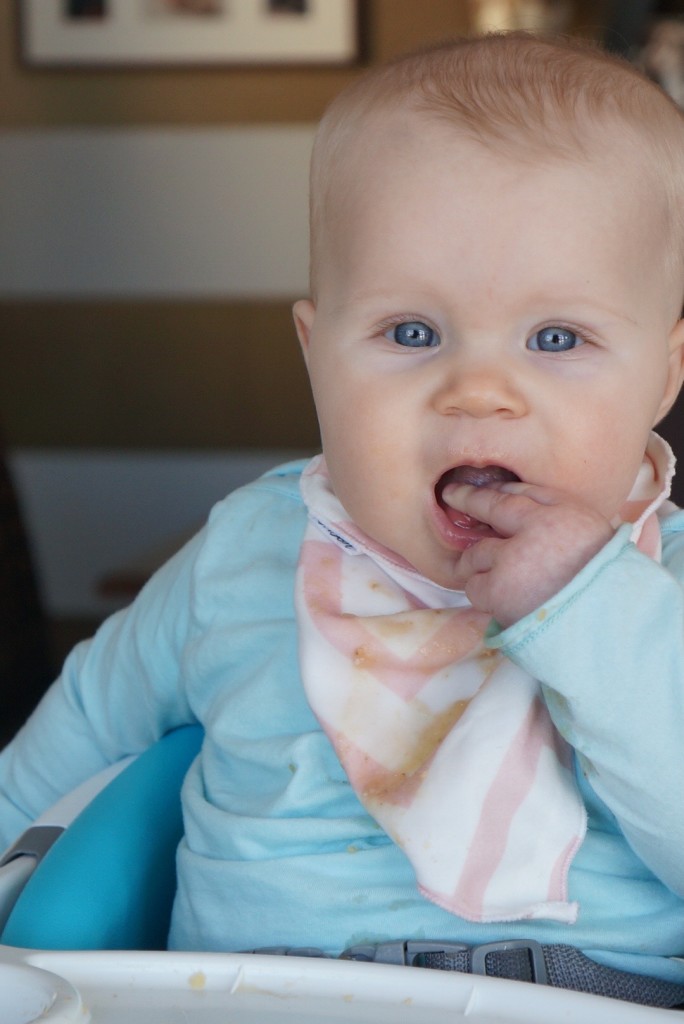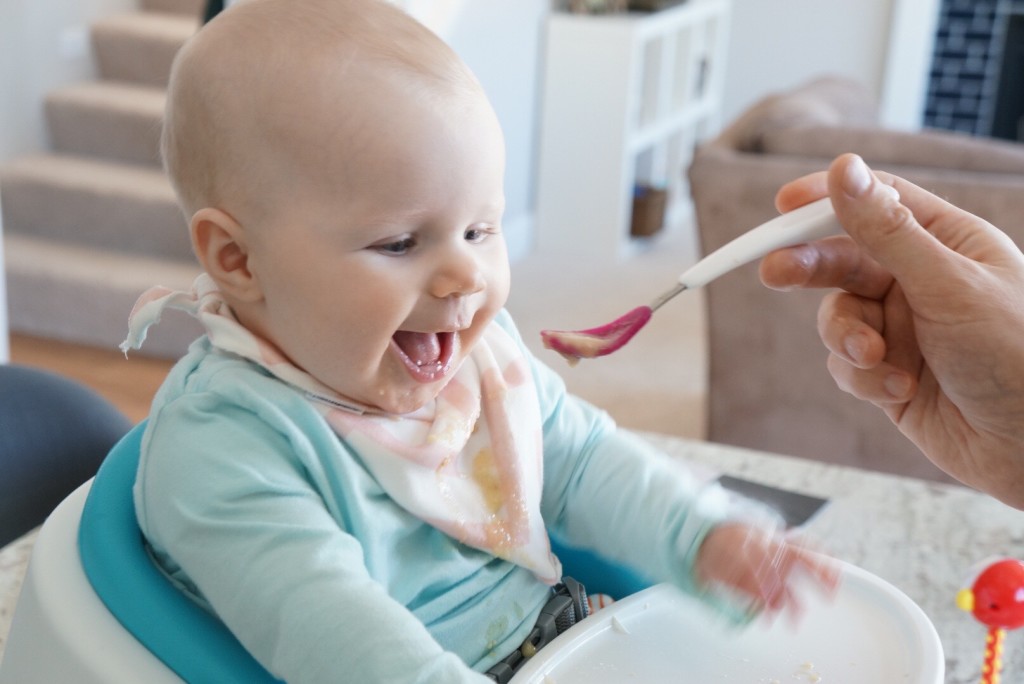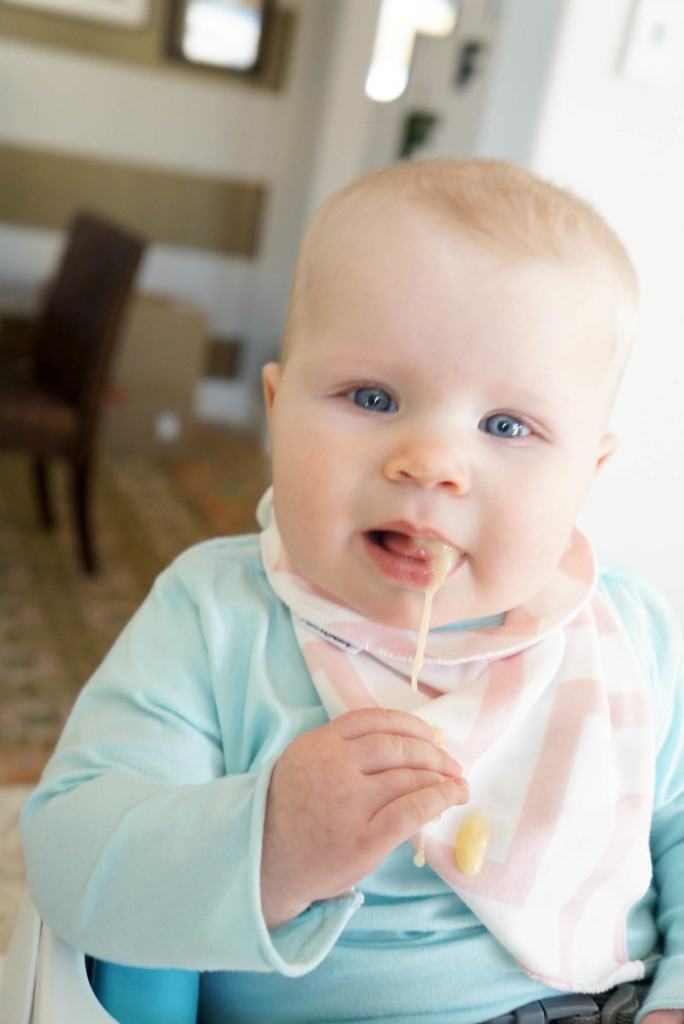Hey everyone! Thank you for the abundance of emails and messages about this month’s “Ask an OT” series. Over half of the questions had to do with tips to start your baby on solids, therefore I decided to break the topic down into a few parts. Feeding is a huge topic to cover and there were so many diverse, interesting questions to answer! Today we are going to start with some basics, which involve setting a strong foundation for feeding success. Even if your child is beyond the introduction to solids phase, I think you can still find relevant information for those days when a kid just refuses everything. We’ve all been there! So here are the fundamentals of feeding babes under one year old.
1. When is the best time to introduce solid foods? Six months old has been the standard for a while, but recent research indicates solid foods may be introduced to infants as young as four months old. It is a choice that you and your pediatrician should make together, primarily based on physical development and oral motor control. (Waverley’s pediatrician and I had an intense discussion about our different viewpoints and settled on five months.) An infant should be able to hold their head up and have moderate upper trunk control/strength prior to introducing solids. This indicates the development of the necessary musculature to handle solid food. Remember, introducing solids means exactly that: introducing a few bites of different solid foods. It does not mean that solid food becomes the primary source of nutrition but rather a compliment to the breast milk or formula. I think people worry about introducing solids too early because of that; however, breast milk/formula should still be the primary source of nutrition until later on in the first year.
2. What are the best foods to start with? Soft fruits and vegetables are the best foods to start with, such as avocados, bananas, or pureed sweet potatoes. Think of foods that are easy to swallow and do not require chewing. Try to provide opportunities to eat and taste real food rather than “baby food.” Use the food you have that is a part of your family’s life! It is sometimes recommended to combine breast milk or formula with the food to start to ease the digestive process and help familiarize taste, but it is not necessary. Start with one food at a time and gradually progress to combining flavors and textures. (Some babes may progress slower, some may skip the gradual progression altogether. Listen to your baby and let them guide their food choices to certain extent.)
3. Do I have to start with rice cereal? No! Not at all. This is actually a pretty big debate at the moment. You may hear a different answer depending on whom you ask, but it is perfectly safe to start with fruits and vegetables. Rice cereal does offer iron supplementation; however, because the primary source of nutrition will remain breast milk or formula then this may not be needed. The goal should be to provide whole, natural first foods.
 4. My baby spit out the food. Now what? Assuming there are no oral motor concerns– keep trying! Seriously, try every. single. day. Just a few bites. Let your babe explore the food with more than his/her mouth. Let babies use their hands, squish it between their fingers, and bring it to their mouth. It will be a mess. It will be a disaster! You have to get over it. There will be a huge mess now but it will gradually get better as they grow more proficient. Learning to eat solids is a developmental skill, which means babies need to practice, practice, practice to improve. You wouldn’t expect a little one to get up and run on their first walking attempt and eating should be regarded in the same manner. Also, an infants’ taste buds regenerate every week. This means there is always potential that a food your babe disliked last week may become their new favorite, so never write-off a particular food based on one refusal.
4. My baby spit out the food. Now what? Assuming there are no oral motor concerns– keep trying! Seriously, try every. single. day. Just a few bites. Let your babe explore the food with more than his/her mouth. Let babies use their hands, squish it between their fingers, and bring it to their mouth. It will be a mess. It will be a disaster! You have to get over it. There will be a huge mess now but it will gradually get better as they grow more proficient. Learning to eat solids is a developmental skill, which means babies need to practice, practice, practice to improve. You wouldn’t expect a little one to get up and run on their first walking attempt and eating should be regarded in the same manner. Also, an infants’ taste buds regenerate every week. This means there is always potential that a food your babe disliked last week may become their new favorite, so never write-off a particular food based on one refusal.
5. When is the best time introduce utensils and how do I get them to use it? It’s never too early to introduce a spoon to a babe. They may not use it appropriately for several months, but it is a great idea to have it handy. There will come a point where they will want a spoon just because you are also holding a spoon. You can let them stir the food with the spoon (again, huge mess!) as they slowly associate spoon + food + mouth. As they progress, you may begin to demonstrate how to use it with hand-over-hand facilitation. Also, simply by eating meals together you are showing how to use utensils, so ensure you are all eating together. Do not expect great proficiency with utensil use until approximately 18 months of age. Until then…have a lot of wipes ready.
 6. Do I have to make my own baby food? I don’t have the time, patience, or desire to do so. You guys, this is totally okay. I happened to make a lot of Waverley’s food when she was a wee babe for my own personal reasons– mostly because we use a lot of salt in our food and because I genuinely enjoyed it. I used a plain old immersion blender or food processor, not a special baby food cooker– which I think may overwhelm people because it is just one more thing to buy. It’s best to incorporate your baby into mealtimes as seamlessly as possible, so if this means mashing up your food for your little one then go right ahead. The key is to ensure what you are eating is safe for the baby (both by texture and ingredients). Encouraging your child to eat what you eat from the get-go is a great way to promote a diverse palate and to avoid the trap of making multiple meals every day as they grow up. Provide a variety of foods now to promote an adventurous eater later. By the time Waverley was 10-12 months she ate what we ate with slight modifications for tricky food. For example, I’d stir in plain Greek yogurt for spicier dishes to cool it down or mash-up tough meat. Although you don’t need to have a freezer stocked of homemade food fit for a baby, I’d also recommend avoiding only serving processed baby food found in grocery stores.
6. Do I have to make my own baby food? I don’t have the time, patience, or desire to do so. You guys, this is totally okay. I happened to make a lot of Waverley’s food when she was a wee babe for my own personal reasons– mostly because we use a lot of salt in our food and because I genuinely enjoyed it. I used a plain old immersion blender or food processor, not a special baby food cooker– which I think may overwhelm people because it is just one more thing to buy. It’s best to incorporate your baby into mealtimes as seamlessly as possible, so if this means mashing up your food for your little one then go right ahead. The key is to ensure what you are eating is safe for the baby (both by texture and ingredients). Encouraging your child to eat what you eat from the get-go is a great way to promote a diverse palate and to avoid the trap of making multiple meals every day as they grow up. Provide a variety of foods now to promote an adventurous eater later. By the time Waverley was 10-12 months she ate what we ate with slight modifications for tricky food. For example, I’d stir in plain Greek yogurt for spicier dishes to cool it down or mash-up tough meat. Although you don’t need to have a freezer stocked of homemade food fit for a baby, I’d also recommend avoiding only serving processed baby food found in grocery stores.
 7. My baby throws their plate on the floor after every meal. Help! Oh. Yes. That phase. It is so fun, isn’t it? Fortunately, you are not alone. Nearly every child throws their plate on the floor in an act of defiance/form of communication (“I’m done!”). Tips for getting through it: Kindly tell your little one that those are not acceptable table manners (they will eventually know what that means), do not overreact– simply continue on with your meal, predict when your little one appears to be closing in on the meal and prevent it from happening, and invest in a million of these plates/bowls with a super awesome suction ring so kids can’t lift the plate off the counter.
7. My baby throws their plate on the floor after every meal. Help! Oh. Yes. That phase. It is so fun, isn’t it? Fortunately, you are not alone. Nearly every child throws their plate on the floor in an act of defiance/form of communication (“I’m done!”). Tips for getting through it: Kindly tell your little one that those are not acceptable table manners (they will eventually know what that means), do not overreact– simply continue on with your meal, predict when your little one appears to be closing in on the meal and prevent it from happening, and invest in a million of these plates/bowls with a super awesome suction ring so kids can’t lift the plate off the counter.
And my own added thoughts that are not in response to questions sent in:
8. Food is a bonding experience for families and people. It is where people gather, talk, enjoy new tastes, start the day, and end the day. Food is emotional and cultural and personal. Food is an integral part of our day-to-day life. Start incorporating your baby in mealtimes from the start. Avoid having separate dinners for the baby and the rest of the family, especially after they turn one year-old. They will miss out on learning how the rhythm of meals work, how to eat, how to share, and how to behave at the table.
9. Give praise for trying new foods, but avoid overtly excited or saddened reactions when a new food is greeted with love or disgust. Simply say you are glad they tried it. Children do not need to love every single food item, just as we don’t, but it is important to set a foundation of trying at least one bite.
10. Talk about tastes, smells, and the experience. Mention how different foods can be sweet, sour, salty, bitter, etc.
11. Start offering finger foods (foods that can be picked up with the fingers so not too small and not too big) around 9 months to promote hand-to-mouth associations, which assist with learning how to use utensils later on.
12. Keep it short and sweet. Babies won’t tolerate sitting up and eating for as long as grownups or older children do. Just a few bites and 10 minutes or so in the chair will be plenty, especially if they are still working on their trunk control.
13. Schedule it into your daily routine. For example, when Waverley started solid foods, she had her meal at the same time every day. It was in the late afternoon after nap and before her next bottle. This timing easily led into the dinner hour and let her know what to expect each day.
14. Reflect on your diet. If you want your baby to grow up eating a rainbow of colors and forgoing fast food, then you need to do that as well. This is not a “do as I say, not as I do” situation! I have really had to recognize how much bread I eat with each meal because as soon as Waverley spies it she wants bread and only bread for all of eternity. Nate has also had to reign in his pre-dinner snacking because she will want snacks and then not eat dinner.
A few safety reminders from me, the OT, otherwise known as Sergeant Safety:
- Never leave your baby unattended while they are eating, especially in the beginning of solid exploration. Choking is real and you need to be there in case something gets caught where it’s not supposed to be. I had several patients with non-fatal food-related choking and their stories will haunt me forever.
- Honey is not recommended for children under 12 months of age.
- Coughing is not bad. Coughing is a sign that reflexes are working properly, so certainly pay attention but do not panic!
- Mind the babe’s positioning. For an optimal experience, ensure the baby is positioned properly for feeding activities. This means seated in a high chair and not hunched over or reclining. Do not offer solid foods when a baby is lying down flat.
Thanks for sticking through until the end! As I mentioned, feeding is such a huge topic (I mean, there are thousands of therapists and healthcare providers who specialize in the this topic alone!) that it is impossible to cover everything in one post. I hope I shared something new with you nonetheless! Do you have any questions or comments? Please leave them in the comment section below or feel free to email me at lesleigh@pearlsonastring.com. Thanks so much for reading. Happy feeding!

